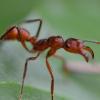Hey there, I was just wondering if anyone had any experience keeping Brachymyrmex depilis? They are very abundant near my house, and despite never seeing the workers (I don't go digging for them) I always find tons of queens on me as I walk home during the summer.
So far, all the queens I have kept have been found walking around with their wings shed, but none of them even lay eggs in a test tube set-up. I don't bother them for months, and when I finally do a check, they are just sitting there with no eggs.
Anyone have any advice?






















